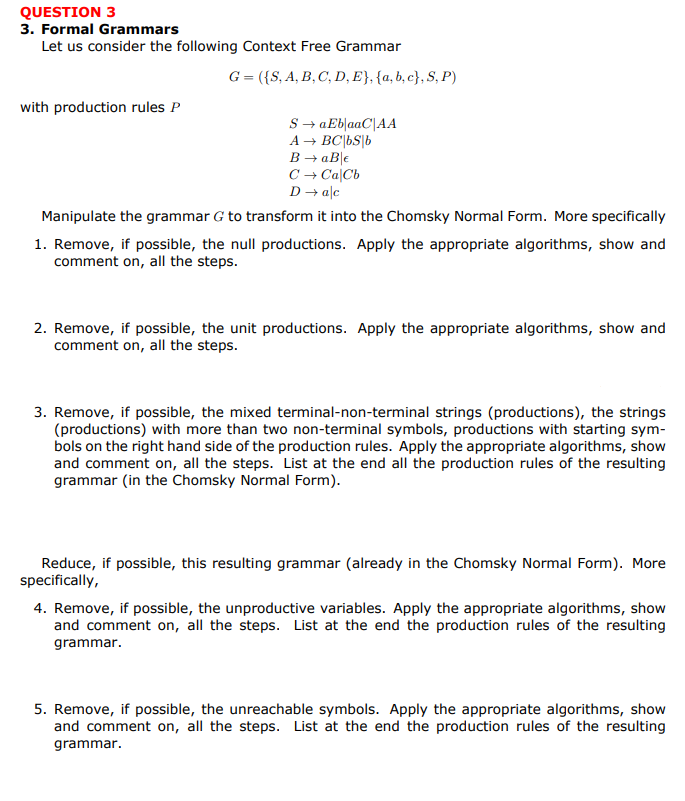3. Formal Grammars Let us consider the following Context Free Grammar G= ({S, A, B, C, D, E}, {a,b,c},S,P) with production rules P SaEb|aaC|AA A → BC|bs|b B → aBle C→CalCb D → alc Manipulate the grammar G to transform it into the Chomsky Normal Form. More specifically 1. Remove, if possible, the null productions. Apply the appropriate algorithms, show and comment on, all the steps.
3. Formal Grammars Let us consider the following Context Free Grammar G= ({S, A, B, C, D, E}, {a,b,c},S,P) with production rules P SaEb|aaC|AA A → BC|bs|b B → aBle C→CalCb D → alc Manipulate the grammar G to transform it into the Chomsky Normal Form. More specifically 1. Remove, if possible, the null productions. Apply the appropriate algorithms, show and comment on, all the steps.
Computer Networking: A Top-Down Approach (7th Edition)
7th Edition
ISBN:9780133594140
Author:James Kurose, Keith Ross
Publisher:James Kurose, Keith Ross
Chapter1: Computer Networks And The Internet
Section: Chapter Questions
Problem R1RQ: What is the difference between a host and an end system? List several different types of end...
Related questions
Question
Can I get the answer for number 5?

Transcribed Image Text:QUESTION 3
3. Formal Grammars
Let us consider the following Context Free Grammar
G = ({S, A, B, C, D, E}, {a,b,c},S,P)
with production rules P
S → aEb|aaC|AA
A → BC|bs|b
B → aB €
C → CalCb
D → alc
Manipulate the grammar G to transform it into the Chomsky Normal Form. More specifically
1. Remove, if possible, the null productions. Apply the appropriate algorithms, show and
comment on, all the steps.
2. Remove, if possible, the unit productions. Apply the appropriate algorithms, show and
comment on, all the steps.
3. Remove, if possible, the mixed terminal-non-terminal strings (productions), the strings
(productions) with more than two non-terminal symbols, productions with starting sym-
bols on the right hand side of the production rules. Apply the appropriate algorithms, show
and comment on, all the steps. List at the end all the production rules of the resulting
grammar (in the Chomsky Normal Form).
Reduce, if possible, this resulting grammar (already in the Chomsky Normal Form). More
specifically,
4. Remove, if possible, the unproductive variables. Apply the appropriate algorithms, show
and comment on, all the steps. List at the end the production rules of the resulting
grammar.
5. Remove, if possible, the unreachable symbols. Apply the appropriate algorithms, show
and comment on, all the steps. List at the end the production rules of the resulting
grammar.
Expert Solution
This question has been solved!
Explore an expertly crafted, step-by-step solution for a thorough understanding of key concepts.
Step by step
Solved in 3 steps with 3 images

Follow-up Questions
Read through expert solutions to related follow-up questions below.
Follow-up Question
can i get the correct solution for this please!

Transcribed Image Text:QUESTION 3
3. Formal Grammars
Let us consider the following Context Free Grammar
G = ({S, A, B, C, D, E}, {a,b,c},S,P)
with production rules P
S → aEb|aaC|AA
A → BC|bs|b
B → aB €
C → CalCb
D → alc
Manipulate the grammar G to transform it into the Chomsky Normal Form. More specifically
1. Remove, if possible, the null productions. Apply the appropriate algorithms, show and
comment on, all the steps.
2. Remove, if possible, the unit productions. Apply the appropriate algorithms, show and
comment on, all the steps.
3. Remove, if possible, the mixed terminal-non-terminal strings (productions), the strings
(productions) with more than two non-terminal symbols, productions with starting sym-
bols on the right hand side of the production rules. Apply the appropriate algorithms, show
and comment on, all the steps. List at the end all the production rules of the resulting
grammar (in the Chomsky Normal Form).
Reduce, if possible, this resulting grammar (already in the Chomsky Normal Form). More
specifically,
4. Remove, if possible, the unproductive variables. Apply the appropriate algorithms, show
and comment on, all the steps. List at the end the production rules of the resulting
grammar.
5. Remove, if possible, the unreachable symbols. Apply the appropriate algorithms, show
and comment on, all the steps. List at the end the production rules of the resulting
grammar.
Solution
Recommended textbooks for you

Computer Networking: A Top-Down Approach (7th Edi…
Computer Engineering
ISBN:
9780133594140
Author:
James Kurose, Keith Ross
Publisher:
PEARSON

Computer Organization and Design MIPS Edition, Fi…
Computer Engineering
ISBN:
9780124077263
Author:
David A. Patterson, John L. Hennessy
Publisher:
Elsevier Science

Network+ Guide to Networks (MindTap Course List)
Computer Engineering
ISBN:
9781337569330
Author:
Jill West, Tamara Dean, Jean Andrews
Publisher:
Cengage Learning

Computer Networking: A Top-Down Approach (7th Edi…
Computer Engineering
ISBN:
9780133594140
Author:
James Kurose, Keith Ross
Publisher:
PEARSON

Computer Organization and Design MIPS Edition, Fi…
Computer Engineering
ISBN:
9780124077263
Author:
David A. Patterson, John L. Hennessy
Publisher:
Elsevier Science

Network+ Guide to Networks (MindTap Course List)
Computer Engineering
ISBN:
9781337569330
Author:
Jill West, Tamara Dean, Jean Andrews
Publisher:
Cengage Learning

Concepts of Database Management
Computer Engineering
ISBN:
9781337093422
Author:
Joy L. Starks, Philip J. Pratt, Mary Z. Last
Publisher:
Cengage Learning

Prelude to Programming
Computer Engineering
ISBN:
9780133750423
Author:
VENIT, Stewart
Publisher:
Pearson Education

Sc Business Data Communications and Networking, T…
Computer Engineering
ISBN:
9781119368830
Author:
FITZGERALD
Publisher:
WILEY